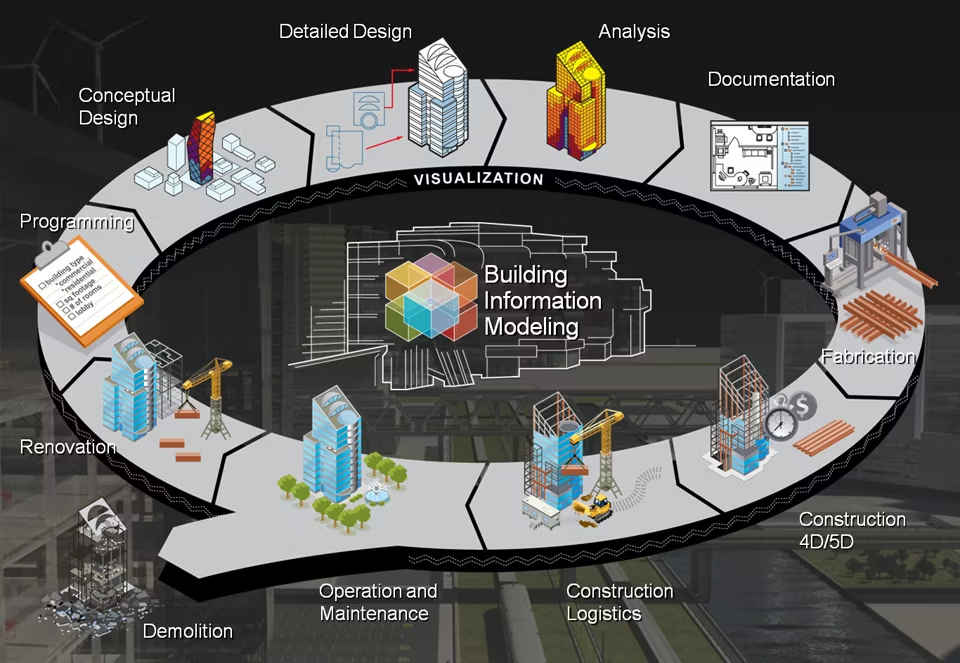VIATechnik specializes in technology for the architecture, engineering and construction industries and works with clients in the realm of virtual reality, BIM services and artificial intelligence.
Building Information Modeling (BIM) is a challenge to fully grasp for a surprisingly simple reason: At its core, it’s a form of systems thinking. A full system designed to facilitate interactions between architects, engineers, customers and construction firms, BIM uses a set of common standards and shared information.
Ask anyone who has worked on a construction site or manufacturing process; they’ll tell you how difficult it is to imagine a complex system as a whole. Managing the system of a company or process presents its own challenges often leading to huge inefficiencies. Managers need more perspective to be able to see these issues.
What makes BIM such a game changer for the construction industry is that, if implemented well, it’s an integrated and open system. While BIM may seem daunting at first, it’s changing construction. Here are seven key ways that BIM can save your firm money and kickstart your architectural business.
1. Better Collaboration
Collaboration may be a major buzzword, but its benefits are pretty clear, particularly in the construction industry. One of the key goals of BIM is to promote collaboration by creating consistent information models throughout the design and construction process, along with greater standardization. The result is less waste and fewer costly revisions on projects.
This is because the building information models allow members of various teams to check in with each other at regular intervals and ensure that designs, systems and structures are coordinated. This makes it easier to know what other people are working on and also how much progress they have made on their work. This collaborative process ties into the time-saving aspects of BIM.

BIM is involved at every stage of a project, from concept to completion; via Buildipedia.com.
2. Increased Time Efficiency
Keeping various companies on the same page can be a huge headache, even on smaller to medium-sized projects. By ensuring everyone has consistent access to the same detailed models, BIM cuts down on time spent checking in with various companies, making it a huge time-saver.
3. Transparency
These same aspects mentioned above also have a tremendous impact on transparency — not just within a single construction firm, but between architects, suppliers and clients. Instead of having to spend time responding to queries from each party about what everyone else is doing, this information is freely accessible to every party, that is, of course, once the parties sign off on all the liability waivers.

Revit screenshot; via Suite Projects and Investments
4. Enhanced Detail
BIM is not simply about sharing information, but also about the quality of that information. This is another area where BIM is set to change things. The level of detail available on BIM models far surpasses what the construction industry has been working with. Those details include information on the exact make, model, specifications, quantities and material of everything used in the construction.
5. Clear Accountability
Integrated within BIM software is the ability to manage the collaborative process by setting ownership of models. This specific accountability built into the system makes it easier for teams to work together without interfering in each other’s work. In addition, it ensures ultimate responsibility is kept clear, reducing potential points of conflict between teams.

Via GAJ Blog
6. Cloud Integration
For firms working on complex projects with workers on-site, in the office or even at other job locations, having data easily accessible can be an enormous benefit. Cloud integration ensures full accessibility in order to ensure information is available on all devices at all times to authorized parties. Once again, this is decreasing the time it takes for any team member to access information they need, leading to time and cost savings across the board.
7. Recording Changes
BIM keeps meticulous records so you don’t have to. The process of BIM aims to maintain detailed version histories of files along with noting who made which changes. If two employees disagree about who altered a particular detail, that information is easily available, or if data gets corrupted, you can always return to the most recent version. This allows for built-in transparency and reliability.
This post written by Traci Beilharzoriginally appeared on VIATechnik’s blog as “7 Money-Saving Benefits of BIM.” Enjoy this article? Check out some more or our Young Architect Guides:
10 Growing Technologies All Architects Should Embrace
The 7 Secrets to Happy Interning
7 Tips for Getting Hired After Graduation
Building Great Architecture Models
5 Lies Told About the Profession You Must Ignore
How to Convince Your Audience With a Powerful Project Narrative
How to Write About Architecture
5 Specifying Tips for First-Time Architects









